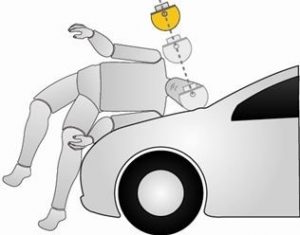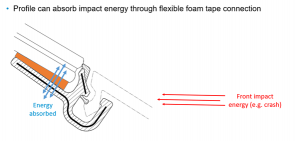Innovative Windshield Profile for Enhanced Pedestrian Safety.
India became the fourth largest Auto market in 2018 with sales increasing 8.3 per cent year-on-year to over 4 million units. But despite millions of cars produced and billions spent on the automotive industry, there is further scope to improve safety. Over 1.5 million people die each year in road accidents, which includes passengers and pedestrians alike.
Every country in the world issues regulations to mandate technologies and safety components in vehicles that provide protection to the vehicle occupants & pedestrians in the event of a Crash. Safety components such as seat belts, airbags and stronger Chassis are fitted as a regulation to offer safety for the passengers which has greatly helped reduce injuries and fatalities of persons inside the cabin.
On the contrary, the people outside the cars viz. the pedestrians remain considerably threatened by lack of reliable pedestrian safety norms and are still the adversely impacted in vehicle accidents. These Pedestrians were mainly exposed to risk when crossing and walking on the road in urban and rural areas.
With the number of automobiles increasing globally, enhancing safety of occupants has been on the top of the minds of automakers. Numerous features like air bags, robust structures, seat belt reminders etc. have been devised to ensure the safety of the occupant. Because of these measures, the number of injuries and fatalities has come down. For the last few years, pedestrian safety has emerged as an important safety aspect.
Globally as well as in India, many pedestrians are hit by cars especially while crossing or walking along with streets in urban as well as rural environment. Lack of safety norms and regulations put pedestrians at threat. A report by the Society of Automotive Engineers highlighted that nearly 15,800 pedestrians were killed in India in 2016.
Sensing this gap, provisions for pedestrian safety are now becoming the part of safety regulations. Presence of pedestrian safety technologies and measures in every passenger vehicle is essential especially when we are headed towards autonomous vehicles. As our dependence on ADAS systems increase, having pedestrian safety features onboard is essential. GNCAP score calculation gives importance to pedestrian safety features in an automobile.
There are some technologies that carmakers can implement in their vehicles to ensure pedestrian safety. One such technology is windshield bottom profile by Elkamet Kunststofftechnik GmbH. Based in Germany Elkamet is the world leader in patented windshield profiles which enhance pedestrian safety in case of a crash.

When a Pedestrian experience a crash, in most of the cases, he is hit at his knees and falls on the bonnet of the vehicle with his head striking the wipers. This causes serious risk of severe head injury which can prove to be fatal. The Elkamet profile reduces windshield size, simplifies the water management cowl components, and recedes the wipers under the Bonnet, thereby making sure that the head of the passenger is safe during an accident. Implementation of the Elkamet profile in the windshield helps a vehicle gain more points for pedestrian safety and secure an overall better rating. gives a better score in Pedestrian Points in GNCAP. A simple yet innovative solution like this should be implemented by every Carmaker.

Apart from improved pedestrian safety and increase in GNCAP pedestrian safety score, in some OEM FEM simulations it was discovered that the foam tape between the profile and the windshield can absorb and “abolish” a lot of kinetic energy during a frontal crash with another car. This energy consumption then protects the passenger cabin from further demolition that can injure the passengers. The Elkamet profile also provides other important benefits such as vehicle light weighting, enhanced aesthetics and aerodynamics and reduced effort and assembly cost. With decades of experience, Elkamet provides this innovative solution to more than 80 carmakers globally with over 40 million cars equipped annually.
For more details on this technology and Solution, contact prashant@quanzen.com




